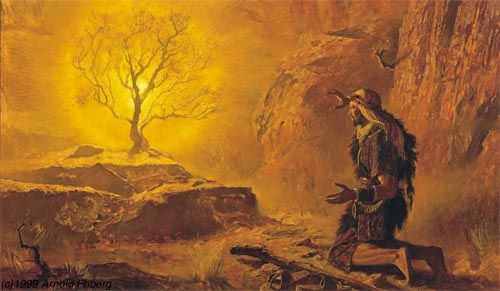Arnold Friberg: Dec. 21 1913 – July 1 2010
A United States citizen Arnold Friberg grew up in Arizona. A devout Mormon he created a large number of both religious and nonreligious works. His artwork has been widely used as the illustrations in Mormon bibles. Friberg famously worked as a designer of the the movie The Ten Commandments where he shaped much of the appearance of the film.
The image contains a number of strong lines, the staff on the ground, Moses’ line of sight, and the the lines created by the ground all directing the eye to the burning bush. The bush is also the brightest part of the painting, a powerful, bright, shining yellow that conveys the burning energy that God’s presence would produce. Unlike in other images of the burning bush, in Friberg’s interpretation the bush is itself not on fire, rather it appears that a small sun is contained inside of the bush. The sun is often connected to gods and power. This interpretation helps convey the importance of the Israelite God and creates an interesting comparison to the primary god of Egypt, the sun god Ra. The bush is on elevated ground compared to Moses, and Moses is not shown dressed ornately, unlike in other representations of this passage. Instead he wears the rough clothing of a sheepherder and is shown to be a comparatively young man.
This image emphasizes the power and importance of God. The image’s use of elevation for the bush, along with Moses’ covering of his face, demonstrates God’s power over Moses. In the Bible passage Moses is said to have “hid his face, for he was afraid” (Exod. 3:6), recognizing the danger of directly looking at or being in the presence of God. The brighten portion of the painting focuses on the bush, containing what looks like a small sun. Like the sun, God is the source of all warmth and life in the image. Also like the way the sun can burn and blind if one looks directly at it, merely being in God’s presence can destroy a human. Unlike in other art work, God is not depicted as having a human appearance, instead YHWH remains as mysterious as the enigmatic name that He gives to Moses. This choice to not give God a human appearance also creates a distance between both Moses and the viewer. God can influence the world and is clearly present, but He is at the same time detached and superior to the surroundings and Moses.
Friberg, Arnold. Moses and the Burning Bush. Oil on Canvas. As reproduced by Friberg Fine Art. https://www.fribergfineart.com/shop/product/moses-the-burning-bush-21×31-canvas-a-p-100-canvas-only-2443?category=21 (November 22, 2016).
Nikolas C. Varsogea
Second Year
Biology Major

